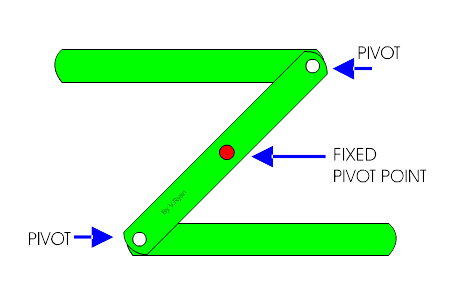Lecture 2: Basics of movement
This lecture will cover a set of basic linkage mechanisms that will work as building blocks for designing movement. Students will learn each mechanism by hands-on construction and be able to design their own movements by combining learned mechanisms at the end of the class.
- Intro to linkage mechanism
- Different types of linkage mechanism
- Read/Watch
- Exercises
- Slides
Linkage
Linkages are rigid bodies connected with hinges that transmit and transform motion. They are simple but efficient mechanical systems that create a variety of movements.

Linkage does…
- Change direction or otherwise alter the path of motion
- Alter speed and/or acceleration
- Change timing of moving parts
- Apply a mechanical advantage
- Create elegant and efficient motion
(Dustyn Roberts (2011), Making Things Move, McGraw-Hill)
Basic linkage-based mechanisms are described below. For more examples, please refer to the lecture slides.
Linkages that transform rotation into linear motion
How to transform the rotational motion of cranks and motors into linear motions was a long-time problem for engineers and inventors who wanted to design machines that need flat surface work. James Watt was one of them who grappled with this problem and there is even a book dedicated to this problem called ‘How to draw a straight line’. If you want to design a movement that is driven by motors and cranks but doesn’t rotate, this type of mechanism will help.
Four-bar linkage
A four-bar linkage is a simple linkage system with many variations. Varying the parameters (s,l,p,q in the image below), the input motion can create a variety of output motions. Below are the four different types of a four-bar linkage.

Changing direction
Once a rotation is transformed into a linear motion, there might be cases where you want to change the direction of it for a desired motion. There are mechanisms that change motion between horizontal & vertical, left & right, and up & down.

Read/watch:
- Straight line linkage
- Four-bar linkage
- Linkages and more
- More to read and watch
Exercises
- Find out more than 2 mechanisms in your surroundings and explain them based on the mechanisms learned.
- Build each mechanism presented with varying parameters.
- Combine at least two different mechanisms driven by one rotational movement (by crank).
- Imagine a desired motion and come up with a mechanism that can fulfill the motion using mechanisms learned.